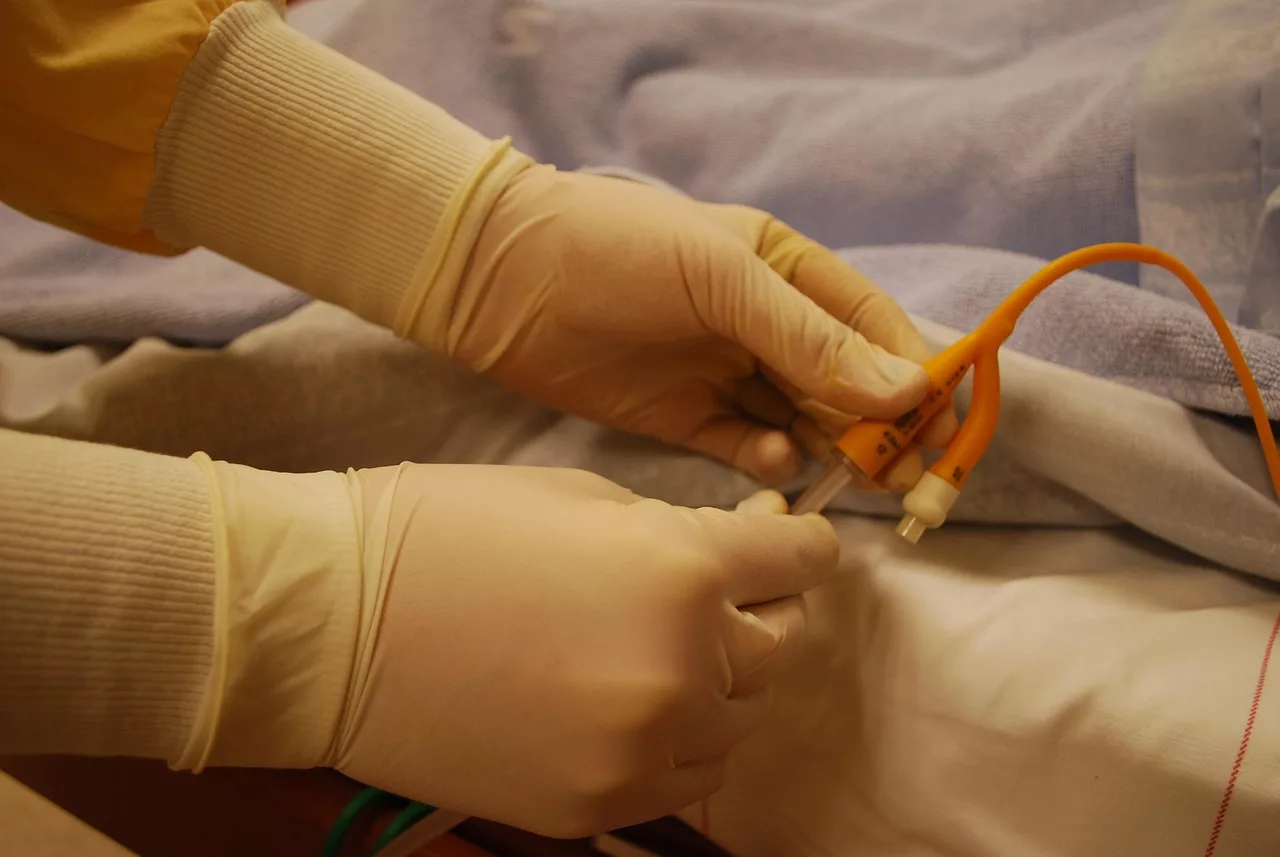Latex allergy is the body’s allergic response to latex (natural rubber) exposure and is characterized by typical allergic symptoms like itching, swelling, hives, and a runny nose etc. The average worldwide prevalence of latex allergy is estimated to be 4.3% in the general population. However, the numbers are higher (9.7%) for healthcare workers frequently exposed to latex.1Wu, M., McIntosh, J., & Liu, J. (2016). Current prevalence rate of latex allergy: Why it remains a problem?. Journal of occupational health, 58(2), 138-144. The allergic response of the body has the tendency to take a severe, life-threatening form, which requires immediate/emergency medical attention. Doctors prescribe antihistamine medicines for mild-to-moderate reactions. However, epinephrine injections are needed for the management of severe allergic responses.
Latex Allergy Types
There are mainly 2 types of latex allergy:
Classic Immediate Allergic Reaction (Type 1 Hypersensitivity Reaction)
Patients with this type have an IgE-mediated allergic reaction to natural rubber. Immunoglobulin E is an antibody that plays a vital role in allergic reactions. Your immune system overreacts to latex contact, and there is a significant bodily response to the innocuous rubber material. You may experience symptoms like itchy eyes, a runny nose, shortness of breath, etc. Rarely, this type of response can lead to grave, life-threatening consequences like anaphylactic shock. Pediatric patients exposed to multiple surgeries are at a greater risk of anaphylactic shock.2Sugimoto, M., Ono, A., Yada, K., Mori, H., Ishibashi, H., Niki, N., & Kagami, S. (2018). Manifestation of intraoperative anaphylactic shock along with latex allergy: a pediatric case report. The Journal of Medical Investigation, 65(3.4), 292-295. Anaphylactic shock manifests as low blood pressure and severe breathing issues (due to airway narrowing). If left untreated, it may even cause death.
Delayed Allergic Reaction (Allergic Contact Dermatitis)
In this cell-mediated allergic response, anomalies are limited to the skin. Therefore, it is also known as type Ⅳ dermatitis and contact dermatitis. An itchy, red rash develops after using latex products. Experts believe that this reaction is actually a response to the other chemicals used in latex product manufacturing rather than latex itself. Generally, symptoms appear after a few hours to four days. While it isn’t considered a true allergic response, individuals with contact dermatitis can also develop an IgE-mediated response.
Some individuals may also experience a third type, i.e., irritant contact dermatitis. It is a mild skin reaction to repeated exposure to latex and is characterized by itching, dryness, scaling of the skin, and burning sensations. It is most commonly seen in healthcare professionals who frequently use latex gloves. The skin symptoms appear 12-24 hours after contact with the allergen.
Latex Allergy Symptoms
The onset of the symptoms depends on the type of allergic response. While patients notice the immediate development of symptoms in the hypersensitivity reaction, the symptoms of contact dermatitis take a few hours to a couple of days to start appearing.

Skin Presentations:
Many healthcare workers report the development of an itchy rash due to repeated exposure to latex gloves. It usually begins with a rash with vesicles on the top of the hand. Sometimes, the rash is eczematous. With continued exposure, the skin becomes dry and scaly.3Gawchik, S. M. (2011). Latex allergy. Mount Sinai Journal of Medicine: A Journal of Translational and Personalized Medicine, 78(5), 759-772. Latex allergy can manifest as hives (raised, red, itchy bumps on the skin). Angioedema (swelling under the skin) can also be seen with the allergic response.
Runny Nose & Watery Eyes:
Many people notice watery, itchy eyes and a runny nose in conjunction with other symptoms of allergy, like pruritus and erythema. Experts suggest that healthcare professionals aptly and quickly identify the signs and symptoms of latex allergy to prevent a severe reaction.4Binkley, H. M., Schroyer, T., & Catalfano, J. (2003). Latex allergies: a review of recognition, evaluation, management, prevention, education, and alternative product use. Journal of Athletic Training, 38(2), 133. There may also be repeated, uncontrolled sneezing due to latex exposure.
Swelling Of Oral Structures:
In moderate-to-severe allergic responses, patients experience orofacial swelling. So, latex allergy, especially due to dental structures (like rubber dam), can manifest as facial swelling, erythema, and mild airway compromise.5Chin, S. M., Ferguson, J. W., & Bajurnow, T. (2004). Latex allergy in dentistry. Review and report of case presenting as a serious reaction to latex dental dam. Australian Dental Journal, 49(3), 146-148. Lip and tongue swelling can also be seen. However, tongue swelling can pose a greater risk as it can interfere with normal breathing.
Gastric Issues:
Gastrointestinal issues are sometimes present in allergic cases. So, you may experience gastric upset with nausea, vomiting, and diarrhea.
Tachycardia & Breathing Difficulties:
Serious consequences of latex allergy include shortness of breath. Several healthcare workers suffering from latex allergy report having a wheeze with breathing difficulties.6Yadav, K., & Gupta, N. (2023). Latex allergy in healthcare workers: a review. Karnataka Paediatric Journal, 38(4), 110-116. There may also be a noticeable increase in the heartbeat, i.e., tachycardia.
Latex Allergy Causes
Allergies happen when the body mistakes a harmless substance/chemical for a harmful object and tries to flush it out of the system. People across the world suffer from different allergies, ranging from pollen to nuts to latex. Whenever the allergen (latex) comes in contact with the body, your immune system starts producing the IgE antibody. This antibody prompts the release of a chemical called histamine.
Histamine is the main chemical agent responsible for the multitude of events taking place in an allergic response. It causes dilation of the blood vessels, initiates inflammation, constricts airways (bronchial smooth muscles), and mediates itching. While IgE mediates the immediate hypersensitivity response, different immune cells cause dermatitis. An important thing to note here is that your immune reaction to latex increases with every exposure. So, repeated exposure can worsen your allergy symptoms!
There are various ways to come in contact with latex. Skin contact is the most prevalent form and occurs when wearing gloves or handling objects containing latex (such as balloons, diapers, etc.). Latex can come in contact with your blood via medical devices/appliances like catheters. You can also get latex by inhalation. Most rubber gloves contain cornstarch, which has the potential to absorb latex particles. When the gloves are removed, these particles become airborne and can be inhaled.
What Objects Contain Latex?
Latex is a natural rubber made out of the Brazilian rubber tree, Hevea brasiliensis. It is present in multiple commonly used items, including:

- Household items (gloves, rugs, etc.)
- Medical gloves
- Condoms and diaphragms
- Urinary catheters
- Balloons
- Dental products (orthodontic rubber bands, etc.)
- Rubber balls
- Adhesive bandages
- School items (erasers, rubber bands, etc.)
- Infant items (pacifiers, bottle nipples, diapers, etc.)
Who Is At Risk?
The following individuals are at a greater risk of suffering from the allergy:

- Healthcare professionals (Paramedics, dentists, etc.)
- Hairdressers
- Food prepares
- People suffering from food allergies (like kiwi, banana, avocado, etc.)7Dilafruz, A., Gulnoza, I., Mansur, A., Khusan, K., & Ogli, A. J. B. (2021). The Problem of Food Allergies and Cross-Allergic Reactions to Fungi and Latex. American Journal of Medicine and Medical Sciences, 11(4), 322-327.
- Pediatric patients with spina bifida
- Patients who have undergone multiple surgeries
Researchers have found an association between latex allergies and food allergies and named it latex-food syndrome. People suffering from latex allergies often have fruit allergies and thus are known to suffer from latex-fruit syndrome.8Gromek, W., Kołdej, N., Świtała, S., Majsiak, E., & Kurowski, M. (2024). Revisiting Latex-Fruit Syndrome after 30 Years of Research: A Comprehensive Literature Review and Description of Two Cases. Journal of Clinical Medicine, 13(14), 4222.
Patients who have undergone multiple surgeries are repeatedly exposed to latex-exposing procedures like catheter insertion, latex glove exposure (by healthcare givers), angiography, etc. This increases their chances of becoming allergic to latex.9Patel, R., Parmar, D., Bhojwani, A., Singh, R., Nandra, R., & Banerjee, R. (2025). Examining perioperative factors in latex-allergic reactions. Journal of Perioperative Practice, 17504589241311106. Spina bifida patients have a higher risk of latex allergy. The prevalence of latex allergy in spina bifida patients was found to be 21% in one study.10Mpungana, Z. (2020). Prevalence of latex allergy in spina bifida patients in Universitas Academic Hospital (Doctoral dissertation, University of the Free State).
Latex Allergy Diagnosis
Your doctor will ask about the symptoms and take a history of your allergies (pollen or food allergy, etc.) and ask about your family history of any allergies. To narrow down the diagnosis, he/she might ask you about the use of latex gloves as part of your profession. Other important pertinent questions in this regard are about multiple surgeries or a diagnosis of spinal bifida. If suspected, your health provider may order the following diagnostic tests:
- Blood test: A blood test detects IgE antibodies that react with latex.
- Skin test: For this, an allergy specialist scratches your skin with a small amount of latex (proteins) and checks how your skin reacts. The extent of dermatitis indicates the severity of the allergy.
Latex Allergy Treatment
There is no cure for latex allergy. However, doctors carry out symptomatic management. Healthcare providers use the following latex allergy medications:
Antihistamines:
These drugs block the action of histamine (by inhibiting its binding with the receptors). This reduces allergy-induced inflammation and constriction of airways. The most commonly prescribed drug for mild-to-moderate latex allergy reactions is loratidine.
Epinephrine injection:
Severe allergic reactions require emergency management. An epinephrine injection is given to treat anaphylaxis induced by latex exposure. It can be a life-saving injection.11Hohler, S. E. (2017). Keeping children with latex allergies safe. Nursing2024, 47(10), 1-5. Children with latex allergies should carry epinephrine auto-injectors to prevent serious anaphylaxis episodes in the school setting.12Tarr Cooke, A., & Meize-Grochowski, R. (2019). Epinephrine auto-injectors for anaphylaxis treatment in the school setting: a discussion paper. SAGE Open Nursing, 5, 2377960819845246. These auto-injectors are easy to use, and both children and adults with allergies can use them.
Steroids:
Allergy-induced swelling can be toned down with steroids. These drugs are also helpful in calming the hyperactive immune system.
Latex Allergy Self-Care & Prevention
Prevention is better than a cure, so it is better to keep yourself safe from latex exposure. You can adopt the following steps to stay safe:
- Avoid contact with commonly known latex products like balloons, latex gloves, etc.
- Identify safe products. Only items with a “hypoallergenic” label should be accepted.
- Inform your healthcare provider (especially your dentist) to use non-latex gloves.
- Carry a non-latex glove with you (will be helpful in the case of an emergency).
- As most latex allergies are linked to food allergies, try to identify which foods cause your allergy and avoid them.
- Keep some antihistamine drugs like loratadine at home to manage mild allergic reactions.
- Carry an epinephrine auto-injector, i.e., EpiPen (and learn to use it) to self-manage anaphylactic shock from an allergy.
Final Word
Latex allergy is the body’s hyperactive response to natural rubber latex. Mainly, there are two types of responses, i.e., an IgE antibody-mediated immediate response that causes tachycardia, shortness of breath (and rarely anaphylactic shock), and a delayed contact dermatitis response where contacted skin develops a red, itchy rash. An abnormal immune system triggers the release of histamine upon coming in contact with latex (via skin contact), which causes inflammation and constriction of airways. Latex is commonly present in gloves, baby diapers, balloons, medical catheters, and bottle nipples, etc. Therefore, healthcare professionals have a higher risk of developing latex allergy. Other risk groups include spina bifida patients and individuals who have undergone multiple surgeries.
Many latex allergy patients also have food allergies. Doctors symptomatically manage mild-to-moderate allergic responses with antihistamine drugs (like loratadine) and steroids. Severe reactions can prove fatal and require urgent management with epinephrine injections. Established allergy patients should carry epinephrine auto-injectors to stay safe from sudden anaphylaxis shocks.
Refrences
- 1Wu, M., McIntosh, J., & Liu, J. (2016). Current prevalence rate of latex allergy: Why it remains a problem?. Journal of occupational health, 58(2), 138-144.
- 2Sugimoto, M., Ono, A., Yada, K., Mori, H., Ishibashi, H., Niki, N., & Kagami, S. (2018). Manifestation of intraoperative anaphylactic shock along with latex allergy: a pediatric case report. The Journal of Medical Investigation, 65(3.4), 292-295.
- 3Gawchik, S. M. (2011). Latex allergy. Mount Sinai Journal of Medicine: A Journal of Translational and Personalized Medicine, 78(5), 759-772.
- 4Binkley, H. M., Schroyer, T., & Catalfano, J. (2003). Latex allergies: a review of recognition, evaluation, management, prevention, education, and alternative product use. Journal of Athletic Training, 38(2), 133.
- 5Chin, S. M., Ferguson, J. W., & Bajurnow, T. (2004). Latex allergy in dentistry. Review and report of case presenting as a serious reaction to latex dental dam. Australian Dental Journal, 49(3), 146-148.
- 6Yadav, K., & Gupta, N. (2023). Latex allergy in healthcare workers: a review. Karnataka Paediatric Journal, 38(4), 110-116.
- 7Dilafruz, A., Gulnoza, I., Mansur, A., Khusan, K., & Ogli, A. J. B. (2021). The Problem of Food Allergies and Cross-Allergic Reactions to Fungi and Latex. American Journal of Medicine and Medical Sciences, 11(4), 322-327.
- 8Gromek, W., Kołdej, N., Świtała, S., Majsiak, E., & Kurowski, M. (2024). Revisiting Latex-Fruit Syndrome after 30 Years of Research: A Comprehensive Literature Review and Description of Two Cases. Journal of Clinical Medicine, 13(14), 4222.
- 9Patel, R., Parmar, D., Bhojwani, A., Singh, R., Nandra, R., & Banerjee, R. (2025). Examining perioperative factors in latex-allergic reactions. Journal of Perioperative Practice, 17504589241311106.
- 10Mpungana, Z. (2020). Prevalence of latex allergy in spina bifida patients in Universitas Academic Hospital (Doctoral dissertation, University of the Free State).
- 11Hohler, S. E. (2017). Keeping children with latex allergies safe. Nursing2024, 47(10), 1-5.
- 12Tarr Cooke, A., & Meize-Grochowski, R. (2019). Epinephrine auto-injectors for anaphylaxis treatment in the school setting: a discussion paper. SAGE Open Nursing, 5, 2377960819845246.

